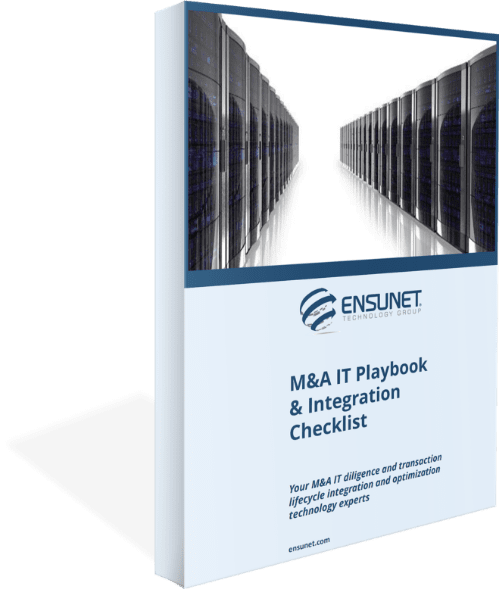M&A IT Playbook & Integration Checklist
Free M&A IT Playbook & Integration Checklist

M&A IT Playbook & Integration Checklist


Acquisitions take place at multiple levels simultaneously. Even at the IT level, there are multiple sub-levels. In this article, we’ll explore what they are, how they factor into a successful acquisition, what the pitfalls are, and how you can avoid them.
When your company is looking to buy another, you’ll have an IT network, and the acquisition target will have theirs. The two will need to be integrated. That’s a given. But making Company A’s computers talk to Company B’s is merely the opening ante.
At the deeper level, you’ll want to ask, and answer, some intrinsically tougher questions:
If you have the right expertise and experience, you can often predict the ROI or economic profit of an acquisition, factoring IT into the equation. A lot of that comes from knowing the models and formulas; indeed, many of the formulas used for acquisitions, generally, can be applied to IT, specifically. We’ll discuss that in more detail in just a minute.
There are far too many stories of enterprises that have fallen short when it comes to integrating that shiny new acquisition. The ensuing problems are manifold:
We’ve seen it numerous times: Company A buys a sexy-looking startup with a promising product portfolio and business case. But then they fail to integrate the systems, processes, applications, and infrastructure. What do they end up with? An expensive (read: “overpriced”) standalone entity that never delivers the hoped-for synergies. This story has a predictable ending: A few years down the line, leadership will complain: “That acquisition never paid off. Let’s get rid of it. Spin it off. Or close it down.”
Was it a failure of IT integration that led to this sorry state of affairs? It’s hardly unusual.
Too many would-be serial acquirers fall short well before Announcement Day. Their due diligence isn’t, well, diligent enough. They don’t look closely into systems and processes. And so they dramatically underestimate what it takes to integrate that new company into the enterprise.
Another common scenario: They’ll start big, then peter out. They’ll do a little bit of integration here and there, and claim—rather prematurely—that they’re done. But they aren’t. Something will come back to bite them—we guarantee it—in the future.
We know of big enterprises that scooped up smaller competitors and apparently gained market-leading presence in the process. But the short-term euphoria morphed into buyer’s remorse when, a few years later, they realized just how much money they were wasting on redundant systems and stovepipes. If only they had, truly, integrated.
A true acquisitions powerhouse puts IT on their side. If you do it right, you can design anywhere/build anywhere, using any of your assets as needed. You can acquire a company that adds breakthrough capability to another already in your portfolio. You can develop “super products.” You can maximize your people and your assets.
Properly integrated, the companies can share data, systems, and infrastructure; even little things, like a common help desk, drive new synergies and efficiencies.
And then there are the apps. Sure, lots of companies use SAP, for example. But everyone’s got it configured differently. You need to create, and push out, a common image—a common problem, that’s uncommonly corrected.
Let’s not forget security, either. The moment that Big Enterprise buys Little Company, the word gets out, fast, and all of the world’s bad actors will swarm to Little Company’s network and ports, seeking ways to surreptitiously infiltrate Big Enterprise.
This requires an in-depth assessment of the candidate company:
You can’t change the company until you own it, so once you do, you must move fast. Fortunately, there are best practices for IT post-merger integration or PMI (you can download our free M&A IT Playbook & Integration Checklist right now, for example).
As we’d hinted above, some of the best practices for general enterprise business can be applied to the specific realm of IT, too. One good example is what’s called parametric cost estimating. It’s the use of historical cost data to get a better handle on future costs. When a big enterprise bids on a multibillion-dollar contract, you can be sure that they’ve already gathered the pricing information for various levels of effort, and used this to build a model that can help with the challenge at hand.
This parametric approach works for IT in PMI, too. You can look back, to see what it costs for app development, for example: How much did it require to develop a given number of lines of code? What do you spend, on average, on hardware, for a given number of employees? While there are sophisticated modeling engines available, you can do this, for starters, using a simple spreadsheet.
The good news: The more you do this, the better you get. It’s wholly logical: The bigger your database of past-cost info, the better equipped you are to get a handle on future situations.
Surprisingly, not many companies apply parametric cost estimating to the IT side of their integrations. If you’d like to join those elite ranks, we can help. Contact us today for a free, no-obligation consultation.
Reach out to the world’s most reliable IT services.